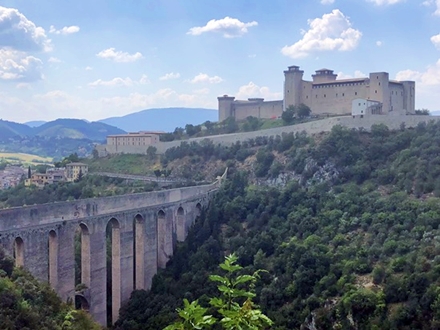Spoleto
I was blessed and could have a trip to Rome overnighting in a sofa bed. And the apartment is located near the Spanish Steps, very privileged yet convenient. Apart from a nice swimming at Anzio, we had a marvellous day trip to Spoleto. Trains from Rome run almost hourly to Spoleto. The journey lasts about 1.5 hours.
Spoleto is an ancient town located in the Umbria region of Italy. The earliest record is dated in 241 BC. Today, traces of the Romans still exist.
This small town is running on a self-sufficient basis. Outdoor escalator and covered moving walkaway connects major parts of the town. One can easily reach the fortification Rocca at the hill top within minutes. I guess it's a strategy to draw visitors by providing convenience both to the tourists and local residents. An interesting Festival Dei Due Mondi is hosted every July which attracts flocks of tourists.
The cathedral architecture style is Romanesque and was built in the second half of 12th century. The key attraction is the fresco by Filippo Lippi, his pupils Fra' Dismante and Piermatteo Lauro de'Manfredi da Amelia. It shows the scenes of the life of the Virgin. The vivid colours and spectacular techniques draw thousands of pilgrims. Lippi successfully amalgamated many different scenes together. Each section wins your admiration. They don't fight but are presented in great harmony. The central part of the fresco, coronation of the Virgin, is used in an advertisement in Rome to attract visits to the town.
Lippi even painted himself into the fresco. It is the man with a black hat at the scene of the death of the Virgin.


The other parts of the Cathedral are also appealing. On the facade is a golden mosaic depicting Christ between the Virgin Mary and St. John. Rose windows decorating the facade are extraordinary.
The interior of the Cathedral are dotted with magnificent paintings too.
After lunch we began our adventure of finding the way of Giro dei Condotti to have breadth taking views of the hilltop Rocca Albornoziana fortress and Ponte delle Torri.
We started the hike by descending from the Cathedral. Somewhere on the right is one of the escalators.
Continue on a big street (but not many traffic) until you see signs of the Giro dei Condotti.
The beginning is a steep and rocky path. After conquering this are well kept shady paths with stunning views of the fortress, the Tower's Bridge and panorama of the picturesque Spoleto.

At the end of the walk is the Basilica di San Pietro. This medieval church is famed for its facade sculptures. They illustrate various biblical stories and medieval themes. They are among the best Romanesque carvings in Umbria.

































Comments